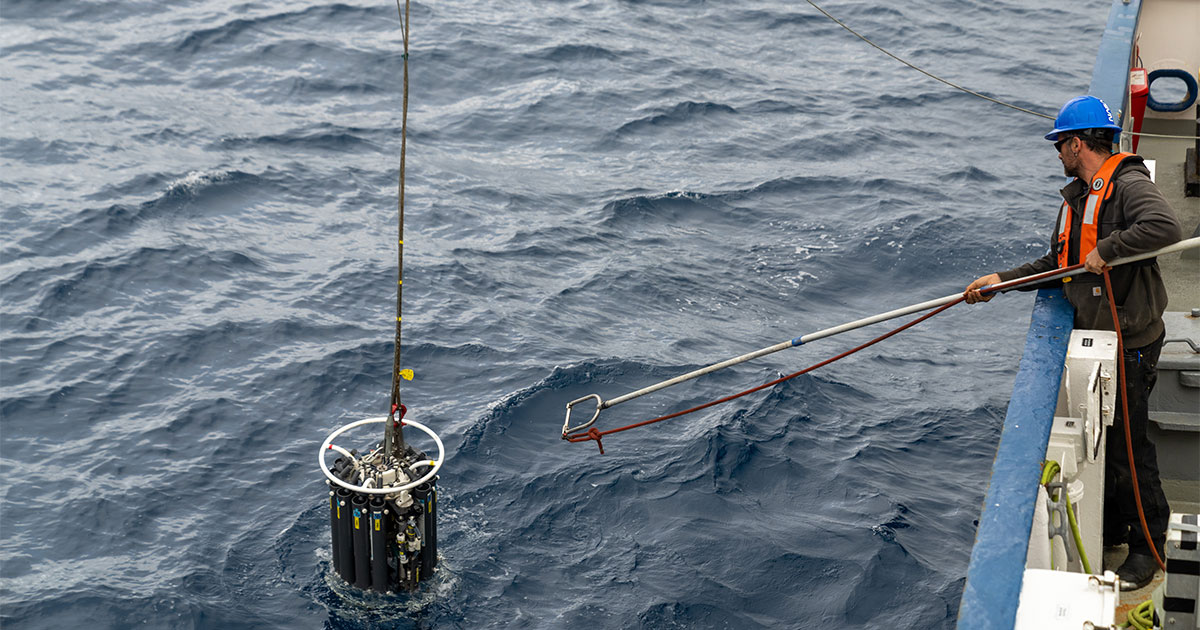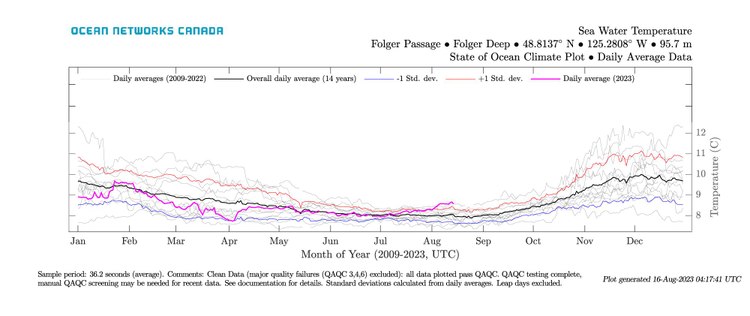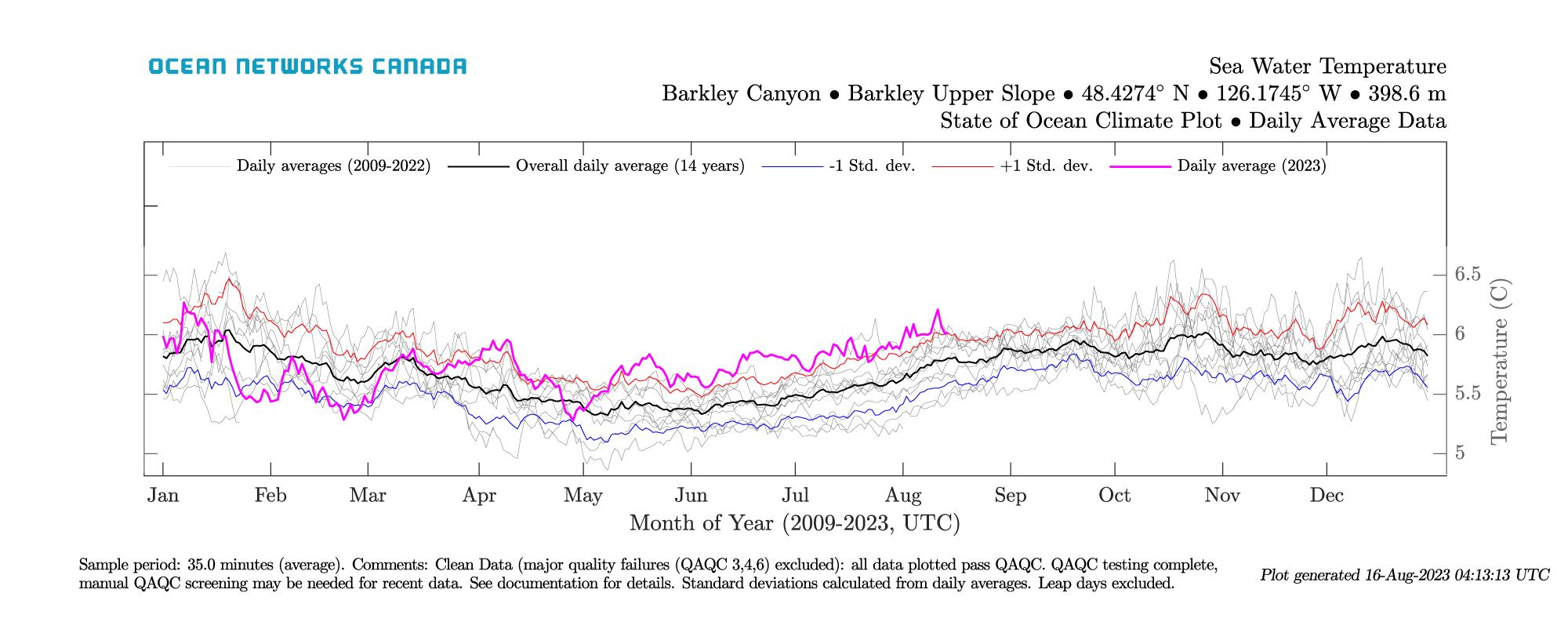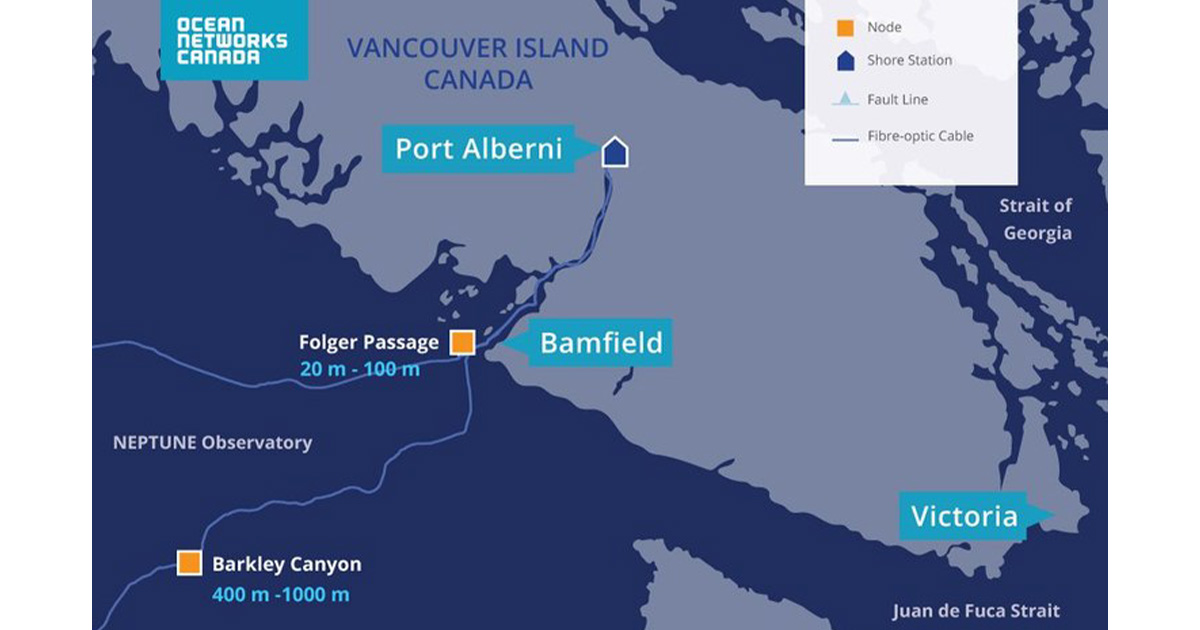Ocean Networks Canada (ONC) has recorded the highest daily average summertime temperatures at two of its seafloor observatory sites in the northeast Pacific Ocean since continuous live monitoring started there in 2009.
ONC, a University of Victoria initiative, operates the North-East Pacific Time-series Undersea Networked Experiments (NEPTUNE) observatory that powers scientific instruments and thousands of sensors, providing real time ocean conditions data. The 800-kilometer NEPTUNE cabled observatory is located off the west coast of Vancouver Island.
ONC senior scientist Kohen Bauer says recent state-of-the-ocean data show that two NEPTUNE sites located on the continental shelf of the northeast Pacific Ocean have been recording high temperatures this summer.
“Temperatures climbed steadily throughout July at ONC’s 95-meter water depth Folger Deep site within Folger Passage, eventually surpassing the highest daily average temperature recorded there for early August since ONC’s monitoring began 14 years ago,” he says.
“Additionally, further offshore at the Barkley Upper Slope site (roughly 400-meter water depth) record seasonal temperatures have mostly persisted since June, largely exceeding the 14-year daily average temperature range at that location. This reveals that even deeper waters at the shelf's edge are anomalously warm for this time of year."
 (Image credit: Ocean Networks Canada)
(Image credit: Ocean Networks Canada)
For example, on August 10, a new daily average temperature high of 8.57 Celsius (°C) was reached at Folger Deep, compared to the previous 14-year record for that date of 8.44 °C. On the same day at Barkley Upper Slope, a new record of 6.01 °C was reached, compared to the previous high of 5.90 °C on that date.
ONC scientific data specialist Stef Mellon evaluates the quality of the data coming from NEPTUNE’s many underwater instruments. She says the anomalous summer ocean temperatures at Folger Deep alerted the data analytics and quality team to conduct extra analyses, and multiple instruments have confirmed the data. [See State of the Ocean plots Figure 2 and 3]
Bauer says there could be a number of possible factors causing warmer summer waters at different locations in the northeast Pacific Ocean, including excess heat from climate change, changes in wind patterns, and variations in the upwelling of deeper waters.
“We live in a time of Earth system extremes, with record global air and ocean temperatures emerging as a major concern. Temperature plays a key role in many interconnected processes in the ocean, and although the mechanistic drivers of the warm summer temperatures we are seeing on the NEPTUNE observatory may not persist, it is worth investigating in more detail. Such observations highlight the importance of ocean monitoring networks in helping us understand these rapidly changing environments.”
 Figure 2: State of the Ocean plot for Folger Deep. The magenta line shows this current year’s daily averages for sea water temperature compared to the overall daily average for 14 years (black) and daily averages from every year from 2009-2022 (grey). The red and blue lines represent the day of year average plus and minus 1 standard deviation, respectively. (Image credit: Ocean Networks Canada)
Figure 2: State of the Ocean plot for Folger Deep. The magenta line shows this current year’s daily averages for sea water temperature compared to the overall daily average for 14 years (black) and daily averages from every year from 2009-2022 (grey). The red and blue lines represent the day of year average plus and minus 1 standard deviation, respectively. (Image credit: Ocean Networks Canada)
 Figure 3: State of the Ocean plot for Barkey Upper Slope in Barkley Canyon. The magenta line shows this current year’s daily averages for sea water temperature compared to overall day of year averages (black) and daily averages from every year (grey) since monitoring began in 2009. The red and blue lines represent the day of year average plus and minus 1 standard deviation, respectively. (Image credit: Ocean Networks Canada)
Figure 3: State of the Ocean plot for Barkey Upper Slope in Barkley Canyon. The magenta line shows this current year’s daily averages for sea water temperature compared to overall day of year averages (black) and daily averages from every year (grey) since monitoring began in 2009. The red and blue lines represent the day of year average plus and minus 1 standard deviation, respectively. (Image credit: Ocean Networks Canada)
This research is supported by the Canada Foundation for Innovation and the Government of Canada's Oceans Protection Plan. It also aligns with United Nations Sustainable Development Goal (SDG) 14, or life below water.



